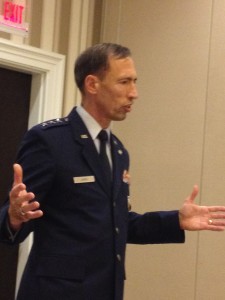Air Force explains automation delay
A popular metaphor in Air Force intelligence circles has analysts drowning in a sea of data. To hear the service's intelligence chief tell it, the service now risks drowning in something else: A sea of proposals for how to handle the video and signals intelligence beamed down by 57 unmanned aircraft patrols and round-the-clock flights by MC-12 Liberty turboprops.
Air Force Lt. Gen. Larry James defended the methodical preparations the service has been making toward automating aspects of its notoriously labor-intensive processing, exploitation and dissemination, or PED, chain.
The Air Force Research Lab has been assigned to act as a "filter because frankly there are a lot of people out there with ideas for a product which may or may not work," James told an audience at the Air Force Association conference in Maryland.
Industry officials, including at least one in the conference audience, are growing frustrated that the service's top generals began publicly calling for automated tools more than a year ago but have yet to match those calls with a process for setting requirements and funding purchases of the tools.
James said an experimental processing system has been set up at an AFRL site so "we can actually take those tools and operate them on the system, with an analyst in the loop, and understand, 'Is this something that's worthy for us to invest in?'"
An adequate science and technology and rapid acquisition process is now in place, James said. Meeting with reporters later, he added that a "roadmap" for purchasing the tools would be established by the intelligence surveillance and reconnaissance review that's been underway for about a year and a half for Air Force Secretary Michael Donley.
"That should be done by the end of the year. Then we'll have a pretty good idea, of, 'Okay this is where we need to be in 2015, this is where we think we'll be in 2018,'" he said.
James made clear that even as the U.S. prepares to hand over the lead to Afghan forces, the service expects to collect more and more video and signals intelligence over Afghanistan and other hotspots.
The Air Force has been holding steady at 57 combat air patrols of Predator and Reaper planes over Afghanistan and "other parts of the Mideast," he said. The pause in growth was necessary: "We've been in the middle of reconstituting our training program, reconstituting our weapons school," he explained.
In November, the holding pattern will end, and the service will begin adding patrols to reach about 65 by May 2014, and "ultimately the capability to surge to 85 combat air patrols."
It's not just the number of patrols that's creating the desire for automation, James said. A big driver will be a next generation version of the Gorgon Stare wide area camera system called ARGUS-IS, short for Autonomous Real-Time Ground Ubiquitous Surveillance-Imaging System.
"The data content and size is not slowing down," James said.
Big data is not always easy to work with either. James said the service has had technical trouble moving Gorgon Stare wide-area motion imagery from location to location, but that he thinks the Defense Information Systems Agency has solved the problem.



